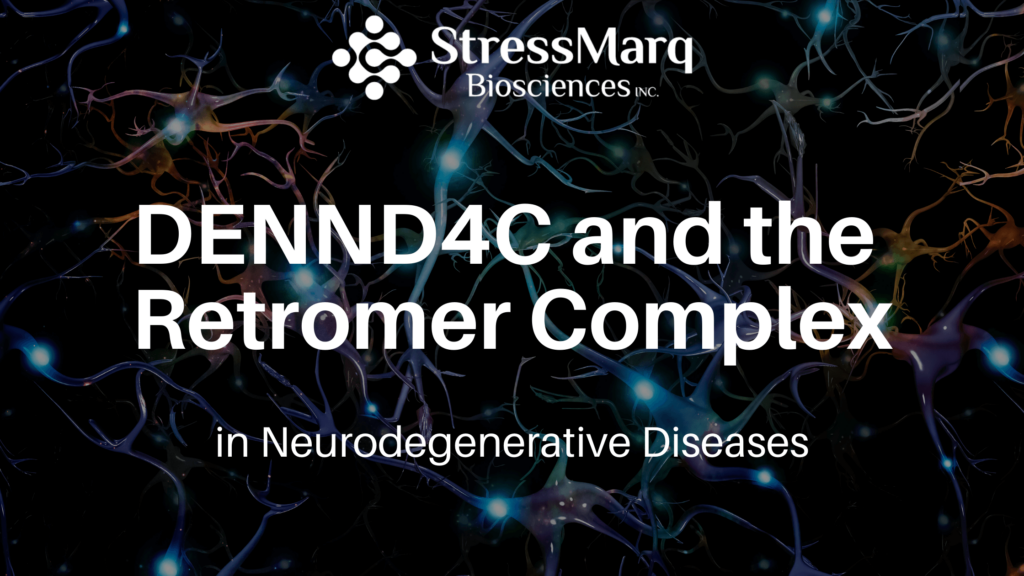DENND4C and the Retromer Complex in Neurodegenerative Diseases
DENN domain-containing protein 4C (DENND4C) is expressed as four different human isoforms, the largest of which has a molecular weight of approximately 218kDa1. It functions as a guanine nucleotide exchange factor (GEF) to activate the Ras-related protein Rab10 (by exchanging the bound nucleotide from GDP to GTP) and plays an essential role in glucose transport by moderating GLUT4 translocation2,3. Recently, DENND4C has been shown to interact with the retromer, a multiprotein complex that is involved in sorting integral membrane proteins to different cellular destinations4. Because defects in the retromer have been linked to neurodegenerative conditions including Alzheimer’s disease and Parkinson’s disease, understanding how these abnormalities impact the retromer’s ability to interact with DENND4C may help to inform the development of effective therapeutics.
What is the DENN family?
The DENN (differentially expressed in normal and neoplastic cells) family comprises 17 different proteins in human, each characterized by the presence of a full DENN domain2. It was first implicated in guanine nucleotide exchange in 1997, when a DENN domain-containing protein with specificity for the Rab3 subfamily was purified from bovine brain5. Since then, the DENN family has become the largest known family of Rab GEFs and has been studied extensively for its role in Rab regulation and function. It is now known that different sub-groups within the DENN family interact with different Rabs. For example, DENND2 proteins regulate Rab9, while the three DENND4 proteins (DENND4A-C) are specific GEFs for Rab102.
How is DENND4C/the retromer complex relevant to neurodegeneration?
The retromer complex is a highly conserved heterotrimer composed of the vacuolar protein sorting-associated proteins VPS26, VPS29 and VPS354. It associates with the cytosolic face of early endosomes, where it interacts with numerous other proteins to export cargo from the endosomal system to the plasma membrane or trans-Golgi network for recycling6,7. A quantitative proteomics study performed in 2016 showed the retromer to interact with DENND4C, an association that was not previously known4. The same study showed DENND4C to exhibit increased binding to a mutated form of the VSP26A subunit (VPS26A p.K297X) compared with the wild-type protein, a finding with particular relevance to neurodegeneration since p.K297X is one of several mutations that has been linked to atypical Parkinsonism8.
What is the role of DENND4C in Parkinson’s disease?
Although the precise role of DENND4C in Parkinson’s disease has yet to be revealed, its enhanced association with the mutant VPS26A subunit brings researchers one step closer to establishing how retromer defects are linked to neurodegeneration. In addition to increased DENND4C binding, the VPS26A (p.K297X) mutant displays a dramatic reduction in binding to sorting nexin 27 (SNX27), a critical component of the trafficking machinery involved in endosomal protein sorting4. In combination, these discoveries provide further links between retromer dysfunction and neurodegeneration to advance researchers’ understanding of complex, life-limiting conditions that currently have no effective cure.
Supporting the study of DENND4C and its role in neurodegeneration
We offer a comprehensive portfolio of high-quality reagents to support researchers studying DENN family proteins and their role in neurodegeneration. Included among these, our anti-DENND4C antibody [3E8] recognizes human, mouse and rat forms of the DENND4C protein and has been validated for Western blotting, immunocytochemistry and immunoprecipitation. Testing performed at the University of Dundee shows this antibody to bind DENND4C in A549 and mouse embryonic fibroblast (MEF) cells but not in an A549 DENND4C knockout model.
![Mouse Anti-DENND4C Antibody [3E8] used in Immunocytochemistry/Immunofluorescence (ICC/IF) on Human A549 cells (SMC-610)](https://www.stressmarq.com/wp-content/uploads/SMC-610_DENND4C_Antibody_3E8_ICC-IF_Human_A549-cells_1.png)
Immunocytochemistry/Immunofluorescence analysis using Mouse Anti-DENND4C Monoclonal Antibody, Clone 3E8 (SMC-610). Tissue: A549 cells. Species: Human. Primary Antibody: Mouse Anti-DENND4C Monoclonal Antibody (SMC-610) at 1:100, 1:500, 1:1000 for 1 hour at RT. Secondary Antibody: Donkey anti-mouse: Alexa Fluor 594 at 1:1000 for 1 hour at RT. Counterstain: DAPI. Courtesy of: Dario Alessi Lab, University of Dundee.
References
- https://www.uniprot.org/uniprot/Q5VZ89
- Family-wide characterization of the DENN domain Rab GDP-GTP exchange factors, Yoshimura S et al, J Cell Biol. 2010 Oct 18;191(2):367-81
- Insulin-stimulated GLUT4 Protein Translocation in Adipocytes Requires the Rab10 Guanine Nucleotide Exchange Factor Dennd4C, Sano H et al, J Biol Chem. 2011 May 13;286(19):16541-5
- Atypical parkinsonism–associated retromer mutant alters endosomal sorting of specific cargo proteins, McMillan KJ et al, J Cell Biol. 2016 Aug 15;214(4):389-99
- Isolation and characterization of a GDP/GTP exchange protein specific for the Rab3 subfamily small G proteins, Wada M et al, J Biol Chem. 1997 Feb 14;272(7):3875-8.
- Retromer and sorting nexins in endosomal sorting, Gallon M and Cullen P, Biochem Soc Trans. 2015 Feb;43(1):33-47
- Retromer: A Master Conductor of Endosome Sorting, Burd C and Cullen P, Cold Spring Harb Perspect Biol. 2014 Feb 1;6(2
- Genetic variability of the retromer cargo recognition complex in parkinsonism, Gustavsson EK et al, Mov Disord. 2015 Apr;30(4):580-4


Leave a Reply